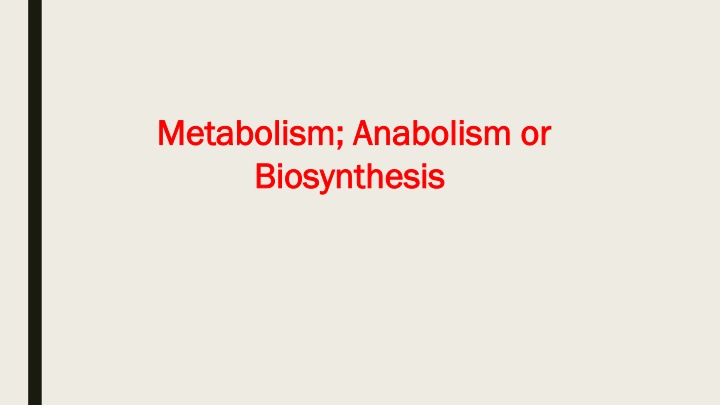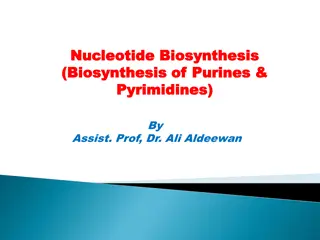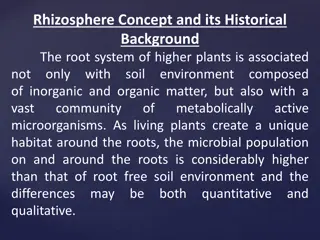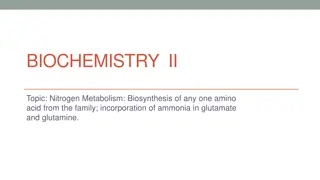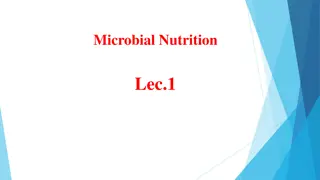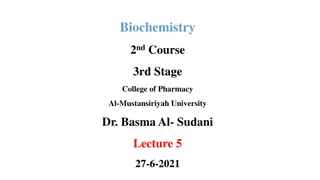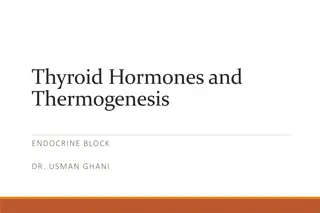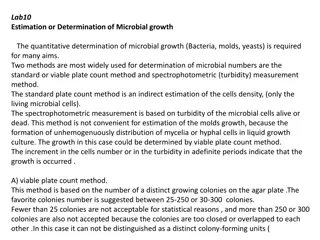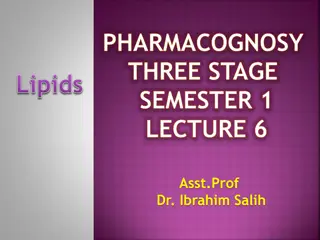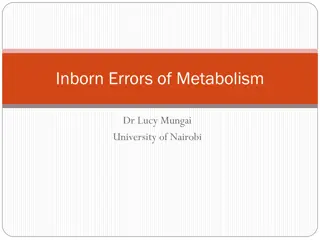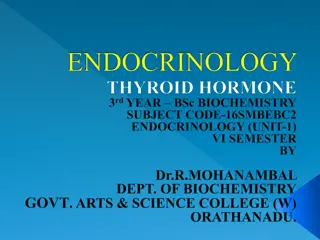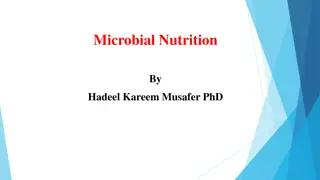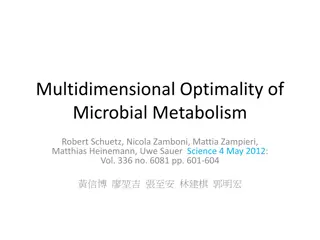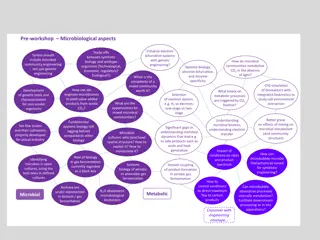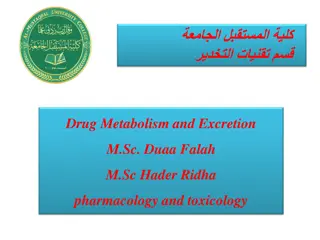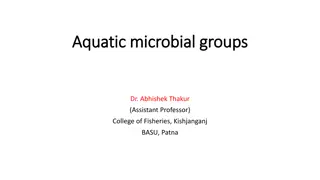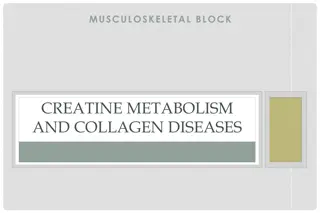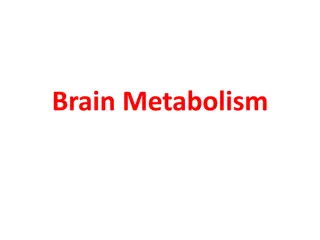Microbial Energy Metabolism and Biosynthesis
Microorganisms utilize various energy sources to engage in biosynthesis for the creation of complex molecules essential for growth and survival. Processes such as photosynthesis, gluconeogenesis, and amino acid synthesis play crucial roles in converting simple precursors into vital biomolecules. The intricate pathways involved in these metabolic processes are fundamental to microbial life and provide insights into the mechanisms driving cellular activities.
Download Presentation

Please find below an Image/Link to download the presentation.
The content on the website is provided AS IS for your information and personal use only. It may not be sold, licensed, or shared on other websites without obtaining consent from the author.If you encounter any issues during the download, it is possible that the publisher has removed the file from their server.
You are allowed to download the files provided on this website for personal or commercial use, subject to the condition that they are used lawfully. All files are the property of their respective owners.
The content on the website is provided AS IS for your information and personal use only. It may not be sold, licensed, or shared on other websites without obtaining consent from the author.
E N D
Presentation Transcript
Metabolism; Anabolism or Metabolism; Anabolism or Biosynthesis Biosynthesis
Microorganisms can obtain energy in many ways, much of this energy is used in biosynthesis or anabolism. During biosynthesis m.o begins with simple precursors, such as inorganic molecules or monomers ,and construct more complex until new organelles and cells arise .
Synthesis of Sugars and Polysaccharides Many M.O can carry out photosynthesis (in which CO2 is incorporate or fix), these autotrophs can convert this inorganic molecule to organic carbon, most common pathway is Calvin-Benson cycle: three different stages can be differentiated :
Carboxylation phase: addition CO2 to riboues 1,5- biphosphate, forming two molecules of 3-phosphoglycerate. Reduction phase: reduction of 3-phosphoglycerate to glyceraldehydes 3-phosphate. Regeneration phase: trioses are used to reform ribulose 1,5-biphosphate ,and some hexose sugars like ; glucose and fructose.
The formation of glucose from CO2 may be summarized by the following balanced equation : 6 CO2+ 6 H2O C6H12O6+ 6 O2 Where: CO2= carbon dioxide H2O = water light is required C6H12O6= glucose O2= oxygen
Sugars formed in the Calvin cycle can then be used to synthesize other essential molecules. The synthesis of glucose from non carbohydrate precursors is called gluconeogenesis. Beside carbon and oxygen, M.O also requires large quantities of phosphorus, sulfur and nitrogen for biosynthesis .
Synthesis of Amino Acids Amino acid synthesis requires construction of the proper carbon skeletons, amino acid skeletons are derived from acetyl-CoA and intermediates of the TCA cycle, glycolysis and Calvin cycle.The ribosome is the site of protein synthesis, synthesis is accurate and rapid .The final step in gene expression is protein synthesis or translation ; the mRNA nucleotide sequence is translated into the A.A sequence of polypeptide chain. Protein synthesis may be divided into 3 stages ; Initiation ,Elongation ,Termination ,this process is discussed in molecular biology .
The Synthesis of Purines , Pyrimidines and Nucleotides Purine and pyrimidine biosynthesis is critical for all cells because these molecules are used in the synthesis of ATP ATP , several cofactors (RNA RNA ) ,deoxyribonucleic acid (DNA), important cell components. Purines and pyrimidines are cyclic nitrogenous bases with several double bonds, purines consist of two joined rings, whereas pyrimidines have only one. cofactors ,ribonucleic acid DNA), and other
. Purines (adenine and guanine) the pyrimidine (uracil, cytosine and thymine) are commonly found in microorganisms. A nucleoside : is a purine or pyrimidines base joined with a pentose sugar, either ribose or deoxyribose. A nucleotide is a nucleoside with one or more phosphate groups attached to the sugar.
Purine Biosynthesis The biosynthetic pathway for purines is a complex, 11-step sequence in which seven different molecules contribute parts to the final purine skeleton, the cofactor folic acid is very important in purine synthesis. Folic acid derivatives contribute carbons two and eight to the purine skeleton. The drug sulfonamide inhibits bacterial growth by blocking folic acid synthesis ,this interferes with purine biosynthesis and other processes that require folic acid .
Pyrimidine Biosynthesis Biosynthesis begins with aspartic acid and carbamoyl phosphate (high-energy molecule synthesized from CO2 and ammonia). Aspartate carbamoyl transferase catalyzes the condensation of these two carbamoylaspartate, which is then converted to the initial pyrimidine product and orotic acid . substrates to form
LipidBiosynthesis A variety of lipids are found in microorganisms, particularly in cell membranes and most contain fatty acids or their derivatives. Fatty acids are monocarboxylic acids with long alkyl chains (the average length is 18 carbons). Some are unsaturated that have one or more double bonds . Most microbial fatty acids are straight chain, but some are branched
Gram-negative bacteria have cyclopropane fatty acids (fatty acids with one or more cyclopropane rings in their chains ). Fatty acid synthesis is catalyzed by the fatty acid synthetase complex with acetyl-CoA and malonyl-CoA as the substrates and NADPH as the electron donor, the process need ATP and CO2. In addition to fatty acid synthesis ,microorganisms also synthesize Triacylglycerol and phospholipids in different pathway.
Deamination: first step in amino acid use it is the removal of the amino group from an amino acid and transferred from an amino acid to an -keto acid acceptor, the organic acid resulting from deamination can be converted to pyruvate ,acetyl CoA ,or a TCA cycle intermediate and oxidized in the TCA cycle to release energy ,it is also can be used as a source of carbon for the synthesis of cell components .Excess nitrogen from de-amination may be excreted as ammonium ion ,thus making the medium alkaline.
References References 1. Microbial Physiology. Albert G Moat, John W Foster, Michael P. Spector. 2002. Fourth Edition. A John Wiley and sons, INC., publication. 2. Microbiology. Lansing M Prescott, John P. Harley, Donald A. Klein.2004. Sixth Edition. Higher Education. 3. Microbial an introduction. 2004. Gerard J Tortora, Berdell R Funke, Christine L Case. Eighth Edition.
